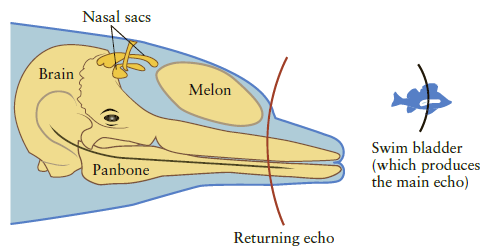Dolphins use sonar as a sixth sense, giving them a three dimensional view of their surroundings via
Question:
Dolphins use sonar as a sixth sense, giving them a three dimensional view of their surroundings via sound. A dolphin’s hearing spans the range from 15 Hz to 150 kHz, making use of the 75–110 kHz range for its echolocation sonar. Sound is emitted in a narrow beam using an organ called the melon (Fig. P13.72), which has a dense core (high sound velocity) compared with the surrounding tissue. The melon acts as an acoustic lens that focuses the sound wave pulse, and the dolphin’s jaw acts as a receiver that channels the appropriate frequencies of the reflected pulse to the ear.
(a) Consider a dolphin chasing a fish as in Figure P13.72. If the fish is 50 cm away, how long does it take a wave pulse to travel from the dolphin to the fish and back?
(b) What is the wavelength of the sonar pulse if the frequency of the emitted sound is 90 kHz? How does this wavelength compare to the size of the fish? Why is that important?
(c) Suppose the dolphin is in pursuit of the fish, with the fish swimming at a speed of 10 m/s and the dolphin swimming at 25 m/s. What frequency for the return pulse does the dolphin hear?
(d) The dolphin can sense the speed of the fish, not by the small shift in frequency away from 90 kHz, but by emitting a series of pulses that sound like clicks. Each click is a pulse of 90-kHz sound with a duration of about 50 µs. Such clicks are emitted at a rate of 900 per second. What click rate would a dolphin detect reflected from the fish in part (c)?
Figure P13.72

Step by Step Answer:

College Physics Reasoning and Relationships
ISBN: 978-0840058195
2nd edition
Authors: Nicholas Giordano





